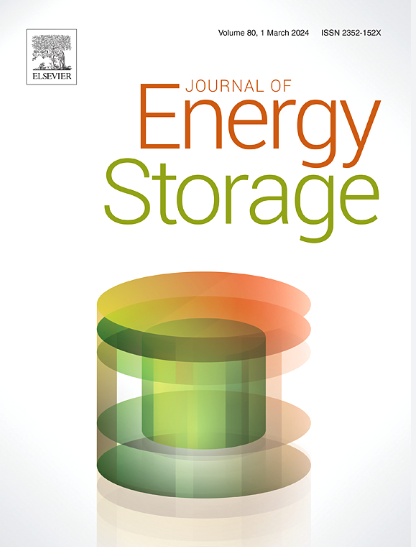容量退化影响了具有广泛储能特性的三层小波神经网络模型的充电状态和寿命周期预测
IF 8.9
2区 工程技术
Q1 ENERGY & FUELS
引用次数: 0
摘要
在电池管理系统(BMS)中,传统的电量状态(SoC)估算的库仑计数方法由于无法考虑自放电和容量退化而受到阻碍,导致SoC读数不准确,电池寿命周期预测不理想。为了解决这一研究空白,本研究提出了一种机器学习驱动的新型三层级联模型,在考虑自放电和容量退化影响的情况下,精确预测各类电池储能系统的充电状态,准确预测其生命周期。利用集成IT6006C-300-75可编程双向电源和IT9000接口软件的硬件试验台模型获取的实时数据,对超参数调整后的最优三层级联机器学习模型进行了训练和测试。此外,为了通过分层预测的过程来预测寿命周期,对功率密度和能量密度作为时间的函数进行了详细的数学推导,并进行了预测和投影。提出的三层机器学习模型不仅考虑了自放电的影响,改进了SoC测量过程,而且将容量退化集成到生命周期预测中,从而为复杂微电网环境下的高级BMS提供了一个鲁棒的解决方案。本文章由计算机程序翻译,如有差异,请以英文原文为准。
Capacity degradation influenced state of charge and life cycle prediction through tri-layered WNN model with extensive energy storage characterization
The conventional coulomb counting method for state of charge (SoC) estimation in battery management systems (BMS) is hindered by its inability to account for self-discharge and capacity degradation, leading to inaccurate SoC readings and suboptimal predictions of battery life cycles. To address this research gap, the study proposes a machine learning-driven novel tri-layered cascaded model to precisely predict the state of charge and accurately forecast the life cycle of various types of battery energy storage systems, considering the effects of self-discharge and capacity degradation. The hyperparameter tuned proposed optimal tri-layered cascaded machine learning model was trained and tested using real-time data acquired from a hardware test bench model, integrating the IT6006C-300-75 programmable bi-directional power supply and IT9000 interfacing software. In addition to that, to forecast the life cycle through the process of layered prediction, the power density and the energy density has been predicted and projected with a detailed mathematical derivation as the functions of time. The proposed tri-layered machine learning model not only refines the SoC measurement process by considering the impact of the self-discharge but also integrates capacity degradation into lifecycle prediction, thus offering a robust solution for advanced BMS in complex micro-grid environments.
求助全文
通过发布文献求助,成功后即可免费获取论文全文。
去求助
来源期刊

Journal of energy storage
Energy-Renewable Energy, Sustainability and the Environment
CiteScore
11.80
自引率
24.50%
发文量
2262
审稿时长
69 days
期刊介绍:
Journal of energy storage focusses on all aspects of energy storage, in particular systems integration, electric grid integration, modelling and analysis, novel energy storage technologies, sizing and management strategies, business models for operation of storage systems and energy storage developments worldwide.
 求助内容:
求助内容: 应助结果提醒方式:
应助结果提醒方式:


